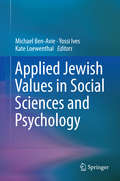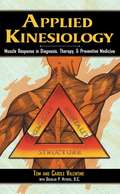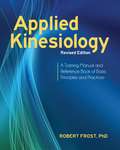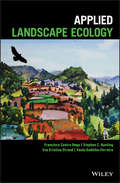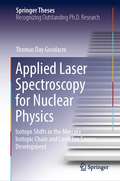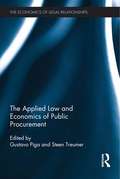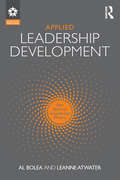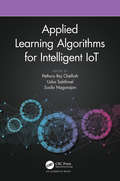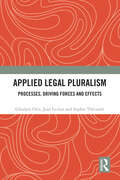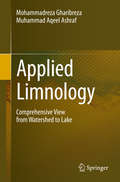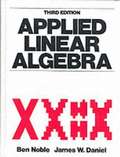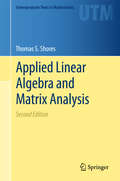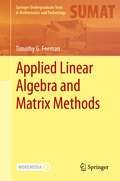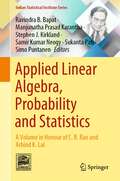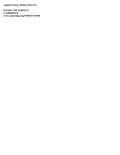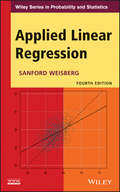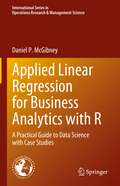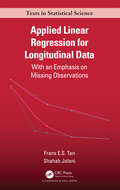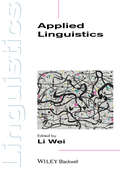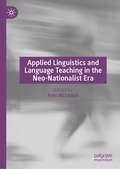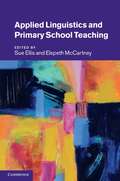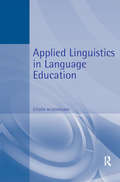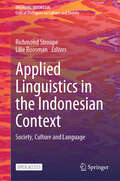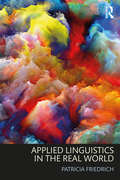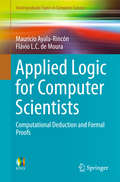- Table View
- List View
Applied Jewish Values in Social Sciences and Psychology
by Yossi Ives Michael Ben-Avie Kate LoewenthalThis volume interweaves concepts and methods from psychology and other social sciences with Jewish ideas and practices in order to address contemporary social issues. This volume brings together pioneering research from scholars in such fields as psychology, education, and religious studies. The authors integrate insights from Jewish texts and practices with the methods and concepts of the social sciences to create interventions that promote the well-being of children, adults, families, communities, and society. Divided into three sections - Education, Psychological Well-Being, Society and Beyond- this book shows how this integrationist approach can deepen our understanding and generate new insights around pressing social challenges to impact positive change in the lives of people and communities.
Applied Kinesiology: Muscle Response in Diagnosis, Therapy, and Preventive Medicine
by Carole Valentine Douglas P. Hetrick Tom ValentineA practical and reliable diagnostic tool that has emerged over the past twenty-five years, kinesiology is the study of the mechanics of bodily motion, especially muscle movements and their relationship to our body systems. Viewing the body as a balanced triad of structure, chemistry, and mentality, applied kinesiology gauges muscle response to pinpoint underlying physical problems. Within 30 minutes, a competent kinesiologist can evaluate bodily functions and provide a readout on the workings of the glands, organs, lymphatic system, circulatory and nervous systems, circulation, and muscle-bone structure. Applied Kinesiology demonstrates how this technique can be of practical use for everyone.
Applied Kinesiology, Revised Edition: A Training Manual and Reference Book of Basic Principles and Practices
by Robert Frost George J. GoodheartThe revised edition of the best-selling book on Applied Kinesiology, Applied Kinesiology, Revised Edition introduces a diagnostic method that uses manual muscle testing to assess the body's "Triad of Health"--structure, chemistry, and psyche. To perform a muscle test, the practitioner applies light pressure that the client then resists. If the client cannot resist the pressure, the muscle "tests weak," indicating a structural problem or imbalance that needs to be resolved. Further applications include working with a muscle that tests strong "in the clear" as a diagnostic tool to determine the effect of stimuli including touch, nutrients, medicines, allergens, emotions, poor posture, and stressful memories. Opening with a detailed description of the history and applications of Applied Kinesiology, the book covers the theory, procedure, and intepretation of the muscle test including diagnosis and correction techniques for areas of weakness. Thirty-three muscle tests for different areas of the body are accompanied by instructive photographs with superimposed anatomical drawings that demonstrate the method and various treatment points. A useful appendix includes a glossary of anatomical terms and special vocabulary; a step-by-step plan for conducting a session; and a list of contacts and sources for Applied Kinesiology materials. Offering a new preface and additional techniques in the areas of manual medicine, orthomolecular medicine, and psychology, this revised edition shares the author's discoveries as well as anecdotal observations to stimulate further research. Table of Contents:Foreword; Introduction; Chapter 1: From Biomechanics to Applied Kinesiology; Chapter 2: Scientific Principles of Applied Kinesiology; Chapter 3: The Muscle Test; Chapter 4: Pretests; Chapter 5: Diagnosis and Correction Techniques; Chapter 6: Muscle Tests; Chapter 7: Applied Kinesiology and Manual Medicine; Chapter 8: Applied Kinesiology and Orthomolecular Medicine; Chapter 9: Applied Kinesiology and the Psyche; Chapter 10: Personal Discoveries and Garnered Methods for Further Consideration; Appendices; Index
Applied Landscape Ecology
by Francisco Castro Rego Stephen C. Bunting Eva Kristina Strand Paulo Godinho-FerreiraAn insightful guide to the concepts and practices of modern landscape ecology Elements of geography, conservation biology, soil science and other disciplines factor into landscape ecology's rich analyses of the ecological and environmental forces at play across different terrains. With its unique, organism-oriented approach to the subject, Applied Landscape Ecology considers the effects of ecological processes upon particular species and places its findings within the context of larger-scale concerns. Students, researchers, and practitioners alike will find this a rewarding and instructive read that offers practical and detailed information on the latest methods and technologies used in the field today. This essential resource: Takes an interdisciplinary approach to landscape ecology Examines the subject within the contexts of specific organisms Covers cutting-edge technologies and methods Represents a collaboration between an international team of landscape ecology experts Whether new to the practice or an established ecologist, anyone with an interest in this exciting and developing field should have a copy of Applied Landscape Ecology at their disposal.
Applied Laser Spectroscopy for Nuclear Physics: Isotope Shifts in the Mercury Isotopic Chain and Laser Ion Source Development (Springer Theses)
by Thomas Day GoodacreThis thesis explores two distinct applications of laser spectroscopy: the study of nuclear ground state properties, and element selective radioactive ion beam production. It also presents the methods and results of an investigation into isotope shifts in the mercury isotopic chain. These Resonance Ionization Laser Ion Source (RILIS) developments are detailed, together with an RILIS ionization scheme that allowed laser ionized ion beams of chromium, germanium, radium and tellurium to be generated at the Isotope Mass Separator On-Line (ISOLDE) facility. A combination of laser spectroscopy with decay spectroscopy and mass spectrometry unambiguously demonstrated a cessation of the extreme shape staggering first observed in the 1970s and revealed the characteristic kink at the crossing of the N=126 shell closure. A series of RILIS developments were required to facilitate this experiment, including mercury “ionization scheme” development and the coupling of the RILIS with an arc discharge ion source. Laser spectroscopy has since become a powerful tool for nuclear physics and the Resonance Ionization Laser Ion Source (RILIS), of the ISOLDE facility at CERN, is a prime example. Highlighting important advances in this field, the thesis offers a unique and revealing resource.
The Applied Law and Economics of Public Procurement: Applied Law And Economics Of Public Procurement (The Economics of Legal Relationships)
by Gustavo Piga Steen TreumerThis book explores Public Procurement novelties and challenges in an interdisciplinary way. The process whereby the public sector awards contracts to companies for the supply of works, goods or services is a powerful instrument to ensure the achievement of new public goals as well as an efficient use of public funds. This book brings together the papers that have been presented during the "First Symposium on Public Procurement", a conference held in Rome last summer and to be repeated again yearly. As Public Procurement touches on many fields (law, economics, political science, engineering) the editors have used an interdisciplinary approach to discuss four main topics of interest which represent the four different parts in which this book is divided: Competitive dialogue and contractual design fostering innovation and need analysis, Separation of selection and award criteria, including exclusion of reputation indicators like references to experience, performance and CV’s from award criteria, Retendering a contract for breach of procurement rules or changes to contract (contract execution), Set-asides for small and medium firms, as in the USA system with the Small Business Act that reserves shares of tenders to SMEs only.
Applied Leadership Development: Nine Elements of Leadership Mastery (Leadership: Research and Practice)
by Al Bolea Leanne AtwaterIntended for courses on leadership, practicing managers, consultants, and practitioners, this approachable guide teaches readers about how to become a leader. By blending the real-world insights of business executive Al Bolea with tested research findings provided by leadership scholar Leanne Atwater, it effectively bridges theory and practice to outline powerful leadership behaviors. Based on Bolea’s original "J-Curve" model of leadership, the authors identify and describe nine essential elements for leadership mastery, including skills such as setting direction, creating key proceses, and nurturing behaviors. Each chapter pairs concrete narratives with succinct research synopses to show how to expand the potential of people and organizations. A unique, experiential text, Applied Leadership Development engages students with self-reflection and self-assessment exercises, and encourages them in their own development as future leaders.
Applied Learning Algorithms for Intelligent IoT
by Pethuru Raj ChelliahThis book vividly illustrates all the promising and potential machine learning (ML) and deep learning (DL) algorithms through a host of real-world and real-time business use cases. Machines and devices can be empowered to self-learn and exhibit intelligent behavior. Also, Big Data combined with real-time and runtime data can lead to personalized, prognostic, predictive, and prescriptive insights. This book examines the following topics: Cognitive machines and devices Cyber physical systems (CPS) The Internet of Things (IoT) and industrial use cases Industry 4.0 for smarter manufacturing Predictive and prescriptive insights for smarter systems Machine vision and intelligence Natural interfaces K-means clustering algorithm Support vector machine (SVM) algorithm A priori algorithms Linear and logistic regression Applied Learning Algorithms for Intelligent IoT clearly articulates ML and DL algorithms that can be used to unearth predictive and prescriptive insights out of Big Data. Transforming raw data into information and relevant knowledge is gaining prominence with the availability of data processing and mining, analytics algorithms, platforms, frameworks, and other accelerators discussed in the book. Now, with the emergence of machine learning algorithms, the field of data analytics is bound to reach new heights. This book will serve as a comprehensive guide for AI researchers, faculty members, and IT professionals. Every chapter will discuss one ML algorithm, its origin, challenges, and benefits, as well as a sample industry use case for explaining the algorithm in detail. The book’s detailed and deeper dive into ML and DL algorithms using a practical use case can foster innovative research.
Applied Legal Pluralism: Processes, Driving Forces and Effects
by Ghislain Otis Jean Leclair Sophie ThériaultThis book offers a comparative study of the management of legal pluralism. The authors describe and analyse the way state and non-state legal systems acknowledge legal pluralism – defined as the coexistence of a state and non-state legal systems in the same space in respect of the same subject matter for the same population - and determine its consequences for their own purposes. The book sheds light on the management processes deployed by legal systems in Africa, Canada, Central Europe and the South Pacific, the multitudinous factors circumscribing the action of systems and individuals with respect to legal pluralism, and the effects of management strategies and processes on systems as well as on individuals. The book offers fresh practical and analytical insight on applied legal pluralism, a fast-growing field of scholarship and professional practice. Drawing from a wealth of original empirical data collected in several countries by a multilingual and multidisciplinary team, it provides a thorough account of the intricate patterns of state and non-state practices with respect to legal pluralism. As the book’s non-prescriptive approach helps to uncover and evaluate several biases or assumptions on the part of policy makers, scholars and development agencies regarding the nature and the consequences of legal pluralism, it will appeal to a wide range of scholars and practitioners in law, development studies, political science and social sciences.
Applied Limnology: Comprehensive View from Watershed to Lake
by Muhammad Aqeel Ashraf Mohammadreza GharibrezaA multidisciplinary study of Bera Lake in Malaysia is presented here, focusing on natural resources throughout the lake's catchment area and assessing environmental impact. This applied limnology study examines issues relating to land development including soil erosion and nutrient loss in the catchment area, severe pollution of water, sediment resources in open waters and wetlands, and reduction of aquatic and bird populations. The chapters provide a comprehensive view of problems, risks and possible mitigation measures associated with this great natural habitat. The book highlights the technology and methods used to estimate both soil erosion rate and nutrient loss from the lake catchment, including an explanation of the measurement of the sedimentation rate in Bera Lake using 137Cs and 210Pb radioisotopes. The author examines the current and historic situation of contamination in sediments, presents an ecological risk assessment, and finally describes a master management plan, proposing practices to mitigate the environmental impacts of existing agricultural projects and practices to control future projects. Readers will learn of a decrease in the watershed supply of water to Bera Lake, of shoaling, degradation of water and sediment quality, and the extinction of several kinds of flora and fauna. This volume also offers an approach to sustainable land use with regard to natural resources conservation.
Applied Linear Algebra
by Ben Noble James W. DanielContains important modern applications such as signal processing and Karmarkar's approach to linear programming. Uses Gauss reduction and 'Gauss-reduced form' as the fundamental theoretical and computational tool. Includes examples and problems using modern software for matrix computations, and describes properties and sources of software for real applied problems. Stresses both the theoretical and practical importance of tools such as the singular-value decomposition and generalized (pseudo) inverses, the QR decomposition, Householder transformations/matrices, and orthogonal projections. Features 1,100 exercises, including optional computer examples and problems.
Applied Linear Algebra and Matrix Analysis (Undergraduate Texts In Mathematics)
by Thomas S. ShoresIn its second edition, this textbook offers a fresh approach to matrix and linear algebra. Its blend of theory, computational exercises, and analytical writing projects is designed to highlight the interplay between these aspects of an application. This approach places special emphasis on linear algebra as an experimental science that provides tools for solving concrete problems.<P><P> The second edition’s revised text discusses applications of linear algebra like graph theory and network modeling methods used in Google’s PageRank algorithm. Other new materials include modeling examples of diffusive processes, linear programming, image processing, digital signal processing, and Fourier analysis. These topics are woven into the core material of Gaussian elimination and other matrix operations; eigenvalues, eigenvectors, and discrete dynamical systems; and the geometrical aspects of vector spaces.<P> Intended for a one-semester undergraduate course without a strict calculus prerequisite, Applied Linear Algebra and Matrix Analysis augments the key elements of linear algebra with a wide choice of optional sections. With the book’s selection of applications and platform-independent assignments, instructors can tailor the curriculum to suit specific interests and ensure students across various disciplines are equipped with the powerful tools of linear algebra.
Applied Linear Algebra and Matrix Methods (Springer Undergraduate Texts in Mathematics and Technology)
by Timothy G. FeemanThis textbook is designed for a first course in linear algebra for undergraduate students from a wide range of quantitative and data driven fields. By focusing on applications and implementation, students will be prepared to go on to apply the power of linear algebra in their own discipline. With an ever-increasing need to understand and solve real problems, this text aims to provide a growing and diverse group of students with an applied linear algebra toolkit they can use to successfully grapple with the complex world and the challenging problems that lie ahead. Applications such as least squares problems, information retrieval, linear regression, Markov processes, finding connections in networks, and more, are introduced on a small scale as early as possible and then explored in more generality as projects. Additionally, the book draws on the geometry of vectors and matrices as the basis for the mathematics, with the concept of orthogonality taking center stage. Important matrix factorizations as well as the concepts of eigenvalues and eigenvectors emerge organically from the interplay between matrix computations and geometry.The R files are extra and freely available. They include basic code and templates for many of the in-text examples, most of the projects, and solutions to selected exercises. As much as possible, data sets and matrix entries are included in the files, thus reducing the amount of manual data entry required.
Applied Linear Algebra, Probability and Statistics: A Volume in Honour of C. R. Rao and Arbind K. Lal (Indian Statistical Institute Series)
by Ravindra B. Bapat Manjunatha Prasad Karantha Stephen J. Kirkland Samir Kumar Neogy Sukanta Pati Simo PuntanenThis book focuses on research in linear algebra, statistics, matrices, graphs and their applications. Many chapters in the book feature new findings due to applications of matrix and graph methods. The book also discusses rediscoveries of the subject by using new methods. Dedicated to Prof. Calyampudi Radhakrishna Rao (C.R. Rao) who has completed 100 years of legendary life and continues to inspire us all and Prof. Arbind K. Lal who has sadly departed us too early, it has contributions from collaborators, students, colleagues and admirers of Professors Rao and Lal. With many chapters on generalized inverses, matrix analysis, matrices and graphs, applied probability and statistics, and the history of ancient mathematics, this book offers a diverse array of mathematical results, techniques and applications. The book promises to be especially rewarding for readers with an interest in the focus areas of applied linear algebra, probability and statistics.
Applied Linear Models with SAS
by Daniel ZeltermanThis textbook for a second course in basic statistics for undergraduates or first-year graduate students introduces linear regression models and describes other linear models including Poisson regression, logistic regression, proportional hazards regression, and nonparametric regression. Numerous examples drawn from the news and current events with an emphasis on health issues illustrate these concepts. Assuming only a pre-calculus background, the author keeps equations to a minimum and demonstrates all computations using SAS. Most of the programs and output are displayed in a self-contained way, with an emphasis on the interpretation of the output in terms of how it relates to the motivating example. Plenty of exercises conclude every chapter. All of the datasets and SAS programs are available from the book's website, along with other ancillary material.
Applied Linear Regression
by Sanford WeisbergPraise for the Third Edition"...this is an excellent book which could easily be used as a course text..."--International Statistical InstituteThe Fourth Edition of Applied Linear Regression provides a thorough update of the basic theory and methodology of linear regression modeling. Demonstrating the practical applications of linear regression analysis techniques, the Fourth Edition uses interesting, real-world exercises and examples.Stressing central concepts such as model building, understanding parameters, assessing fit and reliability, and drawing conclusions, the new edition illustrates how to develop estimation, confidence, and testing procedures primarily through the use of least squares regression. While maintaining the accessible appeal of each previous edition,Applied Linear Regression, Fourth Edition features:Graphical methods stressed in the initial exploratory phase, analysis phase, and summarization phase of an analysisIn-depth coverage of parameter estimates in both simple and complex models, transformations, and regression diagnosticsNewly added material on topics including testing, ANOVA, and variance assumptionsUpdated methodology, such as bootstrapping, cross-validation binomial and Poisson regression, and modern model selection methodsApplied Linear Regression, Fourth Edition is an excellent textbook for upper-undergraduate and graduate-level students, as well as an appropriate reference guide for practitioners and applied statisticians in engineering, business administration, economics, and the social sciences.
Applied Linear Regression for Business Analytics with R: A Practical Guide to Data Science with Case Studies (International Series in Operations Research & Management Science #337)
by Daniel P. McGibneyApplied Linear Regression for Business Analytics with R introduces regression analysis to business students using the R programming language with a focus on illustrating and solving real-time, topical problems. Specifically, this book presents modern and relevant case studies from the business world, along with clear and concise explanations of the theory, intuition, hands-on examples, and the coding required to employ regression modeling. Each chapter includes the mathematical formulation and details of regression analysis and provides in-depth practical analysis using the R programming language.
Applied Linear Regression for Longitudinal Data: With an Emphasis on Missing Observations (Chapman & Hall/CRC Texts in Statistical Science)
by Frans E.S. Tan Shahab JolaniThis book introduces best practices in longitudinal data analysis at intermediate level, with a minimum number of formulas without sacrificing depths. It meets the need to understand statistical concepts of longitudinal data analysis by visualizing important techniques instead of using abstract mathematical formulas. Different solutions such as multiple imputation are explained conceptually and consequences of missing observations are clarified using visualization techniques. Key features include the following: • Provides datasets and examples online • Gives state-of-the-art methods of dealing with missing observations in a non-technical way with a special focus on sensitivity analysis • Conceptualises the analysis of comparative (experimental and observational) studies It is the ideal companion for researcher and students in epidemiological, health, and social and behavioral sciences working with longitudinal studies without a mathematical background. Frans E.S. Tan is an associate professor (retired) of methodology and statisticsat Maastricht University, The Netherlands. Shahab Jolani is an assistant professor of methodology and statistics atMaastricht University, The Netherlands.
Applied Linguistics: Language For The Real World (Introducing Linguistics #Volume 1)
by Li WeiIn this complete survey of the theories, methods, and key findings within applied linguistics, students are introduced to core research questions and the various approaches to tackling these. Provides a comprehensive introduction to this interdisciplinary field of research and practice, dealing with practical issues of language and communication Takes a problem-solving approach, introducing students to key research questions and guiding them through the various ways of tackling these Features additional study aids throughout, including chapter outlines, learning objectives, key terms, research questions and answers, study questions, and recommended further readings Enables students to identify every-day language and communication issues, and to draw on their own personal experiences Edited by a leading figure in the field, heading up an experienced and interdisciplinary team of contributors from the renowned department of applied linguistics at Birkbeck College, University of London – resulting in unique combination of knowledge, skills, and strength from scholars who teach and research together
Applied Linguistics and Language Teaching in the Neo-Nationalist Era
by Kyle McIntoshThis book explores how resurgent nationalism across the globe demands re-examination of many of the theories and practices in applied linguistics and language teaching as political forces seek to limit the movement of people, goods, and services across national borders and, in some cases, enact violence upon those with linguistic and/or ethnic backgrounds that differ from that of the dominant culture. The authors who have contributed to this volume provide careful analysis of nationalist discourses and actions in Brazil, Cameroon, Canada, China, Colombia, Germany, Poland, the United Arab Emirates, the United States, and Vietnam. They offer their unique historical and cultural perspectives on the complex relationship between language, identity, and nationhood in each of these countries, as well as practical responses to the fraught political situations that many language educators and policy makers now face.This book will appeal to researchers in applied linguistics and language teaching, as well as second and foreign language teaching professionals working and living in countries where nationalist sentiments are on the rise.
Applied Linguistics and Primary School Teaching
by Sue Ellis Elspeth MccartneyModern primary teachers must adapt literacy programmes and ensure efficient learning for all. They must also support children with language and literacy difficulties, children learning English as an additional language and possibly teach a modern foreign language. To do this effectively, they need to understand the applied linguistics research that underpins so many different areas of the language and literacy curriculum. This book illustrates the impact of applied linguistics on curriculum frameworks and pedagogy. It captures the range of applied linguistics knowledge that teachers need, and illustrates how this is framed and is used by policy makers, researchers, teacher educators and the other professions who work with teachers in schools. It considers how to effect professional development that works. It is essential reading for primary teachers but also for speech and language therapists, educational psychologists, learning support teachers and all those doing language or literacy research in the primary classroom.
Applied Linguistics in Language Education (A\hodder Arnold Publication)
by Steven McDonough'Applied Linguistics for Language Education' covers those areas of applied language study that are most directly relevant to language teaching, testing, and teacher education. It focuses on the fundamental questions raised for research by the practice of language teaching and research. The reader is thus introduced to the current research climate through consideration of germane controversial issues. If any conclusion about applied linguistic research in the last twenty years is possible, it is that we cannot take anything for granted!Steven McDonough opens with examples of language teaching, teaching materials, and learning a foreign language, which teachers and language learners will recognise, drawing out questions from these which are addressed throughout the rest of the text. Arguments and data from research of all kinds are brought to bear on these and other background issues that are raised, for example: the nature and effects of classroom discourse; the challenges and utility of linguistic theory and linguistic descriptions; what knowing a second language means for proficiency and for processing; nature and nurture in second language learning; how people process language in classrooms and beyond; the role of instruction and the roles of teachers; and measuring achievement.Complex issues are laid out in a clear and accessible style, and many examples are used, mainly, but not exclusively, from English and learning English as a second language. However, the principles apply to learning or teaching any language as a second or foreign language, and 'Applied Linguistics for Language Education' is the most concise overview of current linguistics presently available.
Applied Linguistics in the Indonesian Context: Society, Culture and Language (Engaging Indonesia)
by Richmond Stroupe Lilie RoosmanThis open access edited volume presents a series of studies utilizing a variety of linguistic research techniques to investigate areas of language education, acquisition and assessment, contemporary political debate, modern and historical print media, and clinical language disorders, in the Indonesian context. In doing so, the authors provide a rich and diverse overview of current research in the fields of linguistics and applied linguistics. The initial section focuses on research conducted in educational settings, focusing on English-medium instruction (EMI), reading assessment, discovery-based learning, cultural elements in textbooks, and pre-service teacher preparation in Indonesia, offering recommendations for improving language education. The second section demonstrates the applications of corpus linguistics, focusing on collocation patterns in different languages, lexical use and context of rhetorical markers, and authorship determination. A third section presents investigations related to aspects of historical and contemporary language use in a variety of contexts, including advertisements, political debate, Indonesian print media, and translanguaging and multilingual writings, discussing the social and cultural dimensions of language use in Indonesia. The final section focuses on clinical linguistics, investigating the relationship between language disorders and language use, including spoken narratives provided by patients with Alzheimer's and the structure and time reference use of agrammatic speakers, with valuable insights into the understanding, diagnosis and treatment of language disorders. Brought together in a single volume, the chapters illustrate how linguistic analysis can be applied across a variety of disciplines and research sites. The volume is relevant to linguists, educators, sociologists, historians, and members of the medical community with particular interest in the Indonesian context.
Applied Linguistics in the Real World
by Patricia FriedrichApplied Linguistics in the Real World introduces readers to situations in which applied linguistics can be and is used. Presenting a panoramic view of the interdisciplinary area of applied linguistics and highlighting the diverse range of twenty-first century occupations that have linguistics at their center, this book: Describes, discusses, and furthers the idea that linguistic knowledge is useful everywhere—from forensic investigations to diplomatic talks; from disability studies to creative writing; and from translation studies to machine learning; Breaks new ground, expanding beyond well-established areas of applied-linguistic interest in its inclusion of disability studies, peace studies and the new literature; Provides readers with original research questions and practical applications for them to expand their own research portfolios. Written in an accessible, direct style, Applied Linguistics in the Real World will be essential reading for all students of applied linguistics and is an important addition to the library of anyone who feels passionate and inspired by language matters.
Applied Logic for Computer Scientists: Computational Deduction and Formal Proofs (Undergraduate Topics in Computer Science)
by Mauricio Ayala-Rincón Flávio L. C. de MouraThis book provides an introduction to logic and mathematical induction which are the basis of any deductive computational framework. A strong mathematical foundation of the logical engines available in modern proof assistants, such as the PVS verification system, is essential for computer scientists, mathematicians and engineers to increment their capabilities to provide formal proofs of theorems and to certify the robustness of software and hardware systems. <P><P> The authors present a concise overview of the necessary computational and mathematical aspects of ‘logic’, placing emphasis on both natural deduction and sequent calculus. Differences between constructive and classical logic are highlighted through several examples and exercises. Without neglecting classical aspects of computational logic, the authors also highlight the connections between logical deduction rules and proof commands in proof assistants, presenting simple examples of formalizations of the correctness of algebraic functions and algorithms in PVS. <P> Applied Logic for Computer Scientists will not only benefit students of computer science and mathematics but also software, hardware, automation, electrical and mechatronic engineers who are interested in the application of formal methods and the related computational tools to provide mathematical certificates of the quality and accuracy of their products and technologies.
